Founding & Early Years of AASU
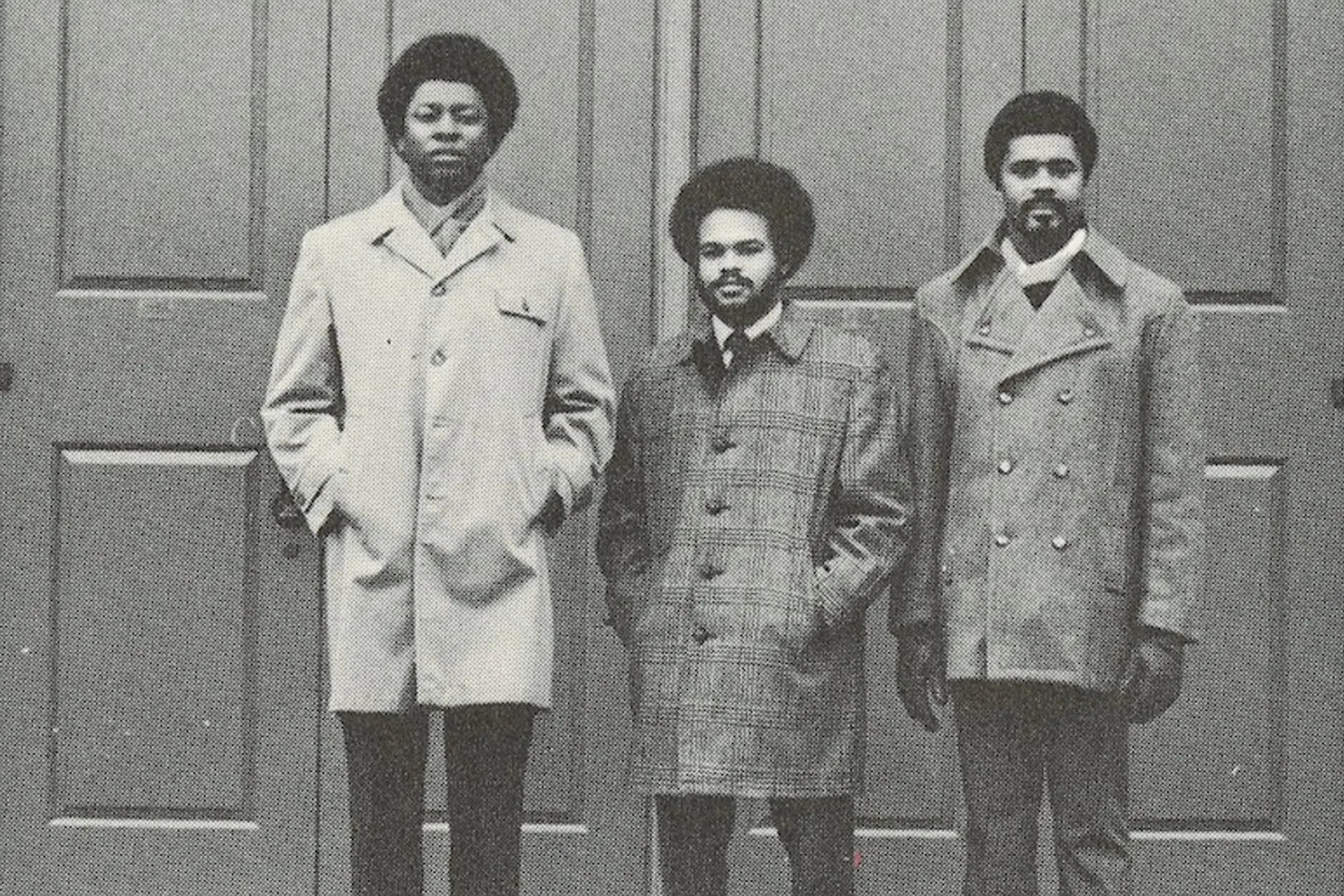
AASU Founders
The African–American Student Union (AASU) at HBS emerged from the turbulence of the late 1960s, years marked by large–scale urban riots across the country, protests against the Vietnam War, and the assassinations of Dr. Martin Luther King Jr. and Robert F. Kennedy. In 1968, AASU was launched as the Afro–American Student Union. Its founders were committed to addressing challenges they experienced as a racial minority in the classroom as well as broader socio–economic issues faced by African Americans nationwide. In a letter to faculty members, they stated: "(1) the seriousness of the racial situation and the socioeconomic condition of Black people demand a major and positive response from all institutions which form part of our society; and (2) Harvard Business School, as one of the major educational institutions in the nation, must accept its share of the challenges and risks associated with the upgrading of educational opportunities of Blacks and other minority groups." (1)
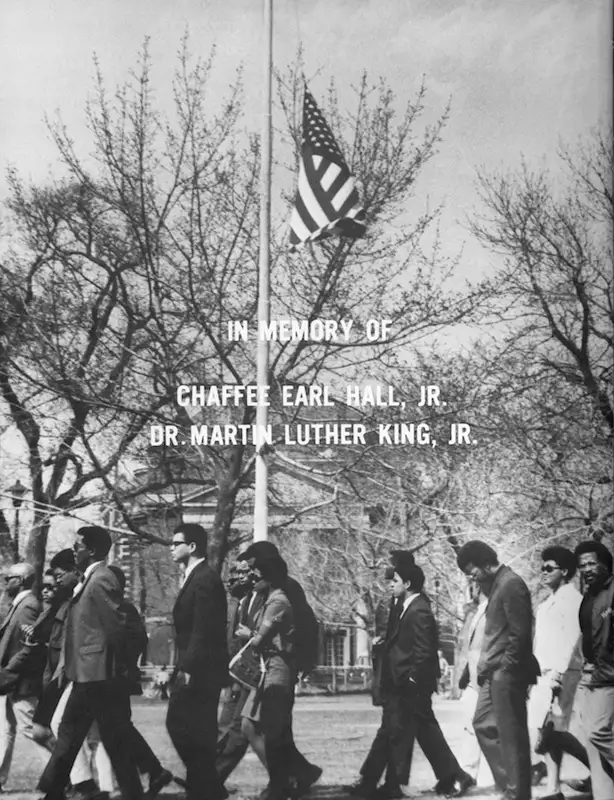
HBS Annual Report, 1968. Baker Library, Harvard Business School.

Demonstration march for peace, ca. 1968. Courtesy of Radcliffe College Archives, Schlesinger Library, Radcliffe Institute, Harvard University. olvwork350305
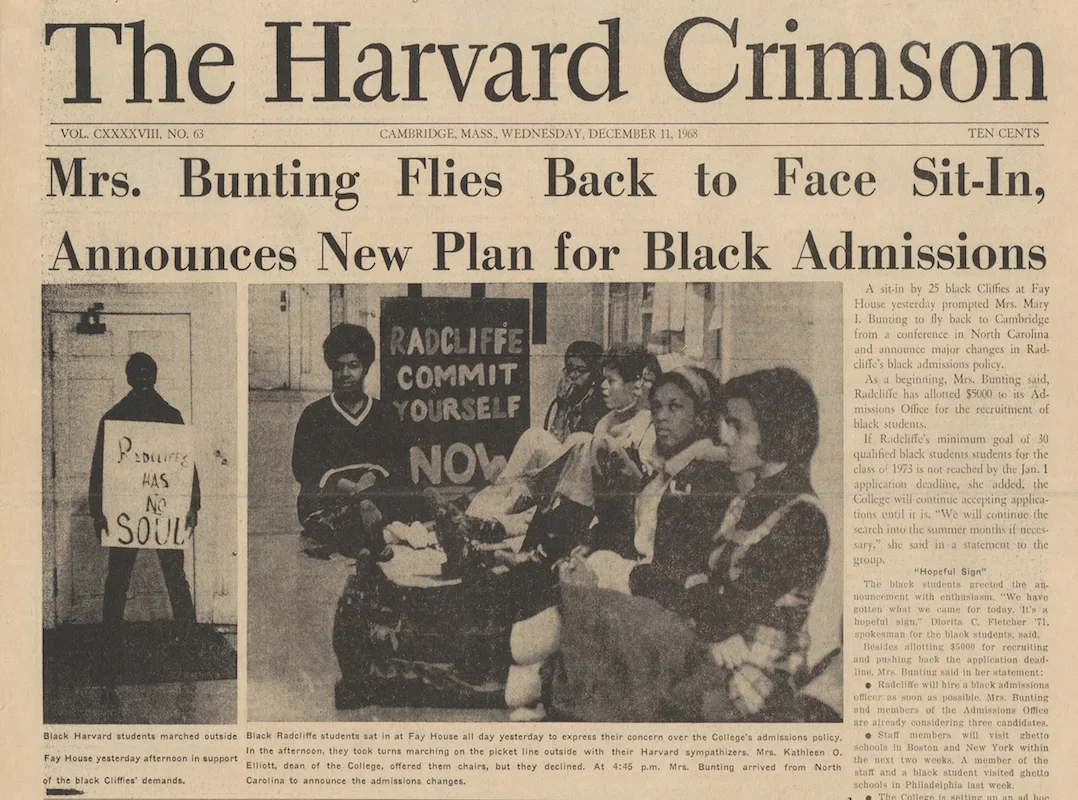
Student unrest at Harvard and Radcliffe Colleges, December 11, 1968. Courtesy of Radcliffe College Archives, Schlesinger Library, Radcliffe Institute, Harvard University. olvwork305911
In 1968, mounting protests against racial injustice and the war in Vietnam were raging across the country and across the river from HBS, on the Harvard campus. Dr. Martin Luther King Jr. was assassinated on April 4, 1968. A photograph of students walking past the flag flying at half-mast appeared in the HBS 1968 yearbook, referencing King and Chaffee Earl Hall Jr., administrative director of the MBA program, who had died the month before.
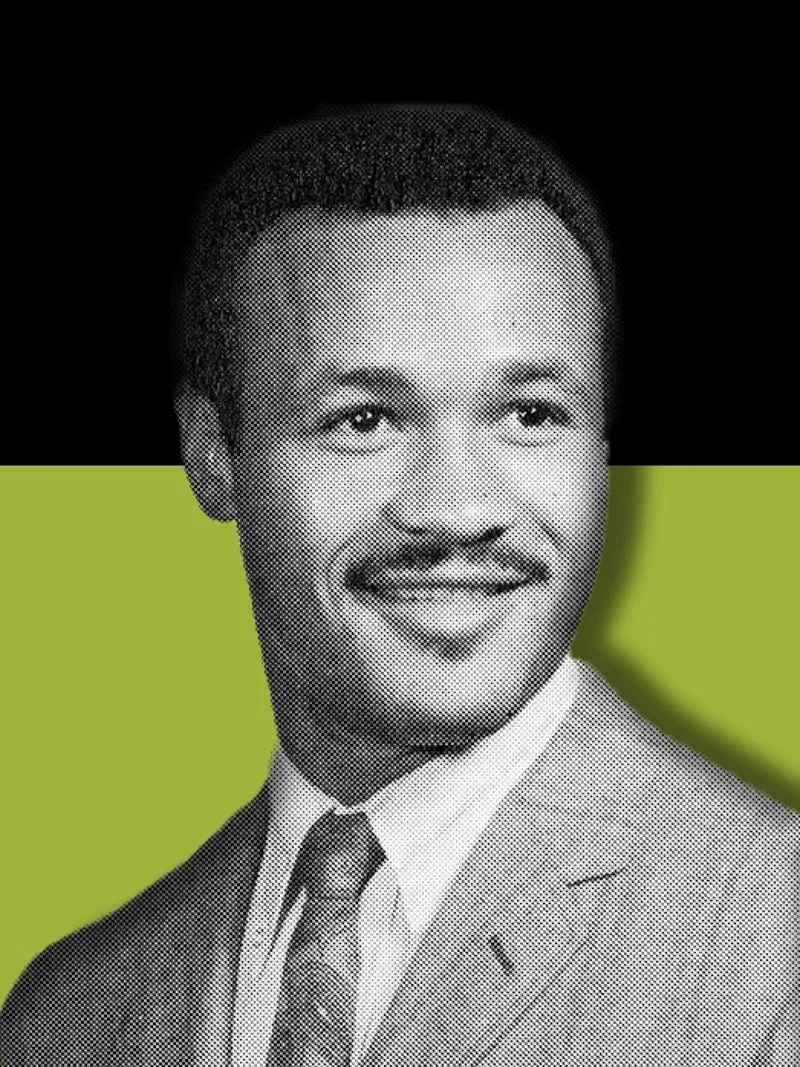
Clifford E. Darden. HBS Annual Report, 1969. Baker Library, Harvard Business School.
Clifford E. Darden
MBA 1969, DBA 1982
Clifford E. Darden developed the organizational strategy of AASU and became its first chair. "We couldn't just sit on the banks of the Charles River," he wrote, "and do nothing at a time when racial oppression and discrimination were still a reality in many parts of the country." (2) Darden later recounted, "After Dr. King was assassinated, that really had a major impact on me, so much so that I contemplated dropping out of the MBA Program.... [B]ut I had resolved, 'No, I am not going to drop out. I am going to stay here and try to make a difference, and I am going to start with pulling this organization together.'" He explained that he counted on members of the class of 1970 "to staff the new organization and make it fully functional and credible as the collective voice of black students at HBS. We were the first student group at HBS formed on some basis other than professional aspirations." (3)
Darden is Professor in Organizational Theory and Management, Emeritus at Pepperdine University's School of Business. He is author of 34 cases and several book chapters on management. Darden served on the Harvard University Board of Overseers Visiting Committee for HBS from 1995 through 2000.

A. Leroy Willis. HBS Annual Report, 1969. Baker Library, Harvard Business School.
A. Leroy Willis
MBA 1969
"[W]hen Dr. King was assassinated, I think our commitment went up a few notches . . . that was when we decided that we would put our MBAs on the line, to really put in the energy and to exhibit the courage that was needed," A. Leroy Willis, a co–founder of AASU, remembered. (4) Upon the discovery that he was the only Black student in his section, Willis went to see Dean George P. Baker. Willis recalled, "He listened to me and said, 'You're right. We should try to do better than what we're doing.' So over time I got to know him—he was really a great guy–and shortly thereafter I met Clifford Darden.... Clif and I met with Charles Brown, the head of the Afro American Student Association at UC Berkeley, where we got to understand what a black student union was. It became the model for us setting up our student union." (5)
Willis was the first African American graduate of the College of Arts and Sciences at the University of Virginia in 1962. He became the first African American head of HBS's Business Assistance Program in Roxbury. He has been a key activist leader in the community development efforts of major U.S. cities including San Francisco and Los Angeles and runs a real estate consultancy firm in Los Angeles.
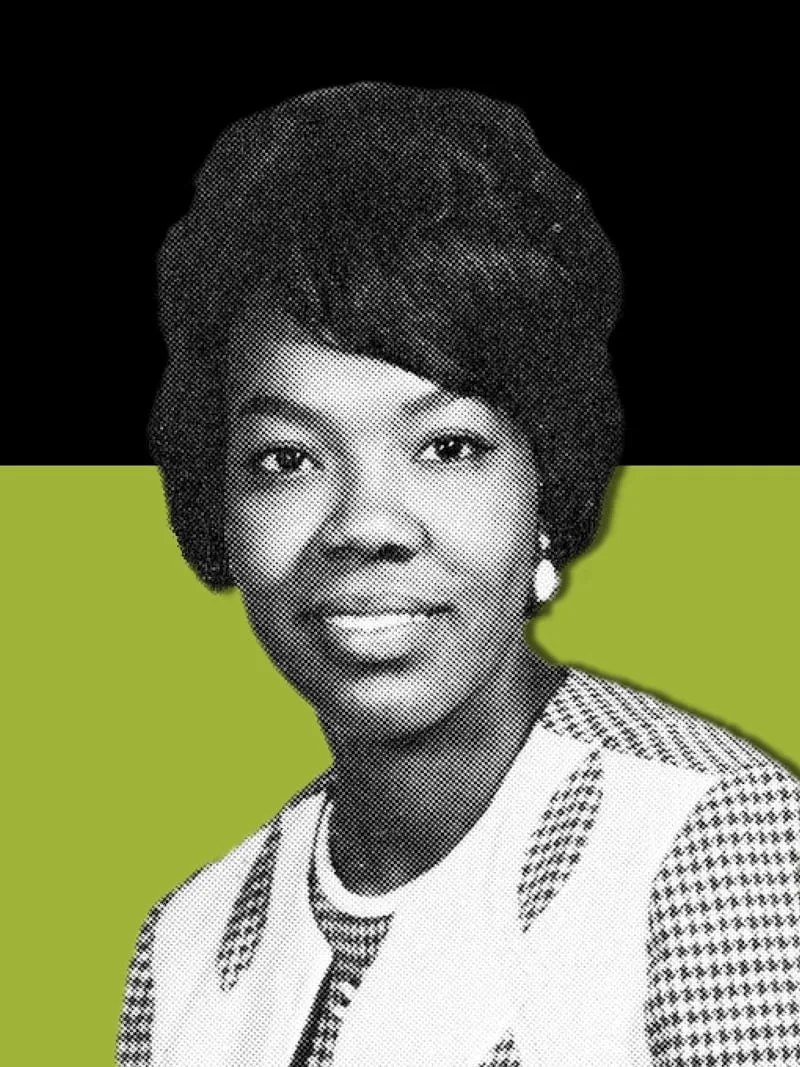
Lillian Lincoln Lambert. HBS Annual Report, 1969. Baker Library, Harvard Business School.
Lillian Lincoln Lambert
MBA 1969
The first African American woman student at HBS, Lillian Lincoln Lambert recalled, "[W]e went to Dean Baker one day, and just asked, why are there so few black students? And he said that they really couldn't find them. So we said, we'll help you. We'll go back to our alma maters and do some recruiting if you will provide the funds to do it, and he agreed to do that." (6) Lambert said, "[I]t was also about just seeing some faculty and staff who looked like you. When you walked down the hall at the time, there were no black and no women faculty members, so the women students I'm sure felt some of that. We dealt with both race and gender issues." (7) Overall, Lambert is pleased that AASU "has been effective and that the School recognizes and appreciates the hard work that we've put into making the organization what it is today. At the time I was doing it, I had absolutely no idea it would have that impact." (8)
An author and public speaker, Lambert founded and led Centennial One, a building services contracting company that grew to 1,200 employees in six states and over $20 million in revenue. She ran the enterprise for 25 years. Lambert received the Alumni Achievement Award, the highest honor conferred by HBS, in 2003.
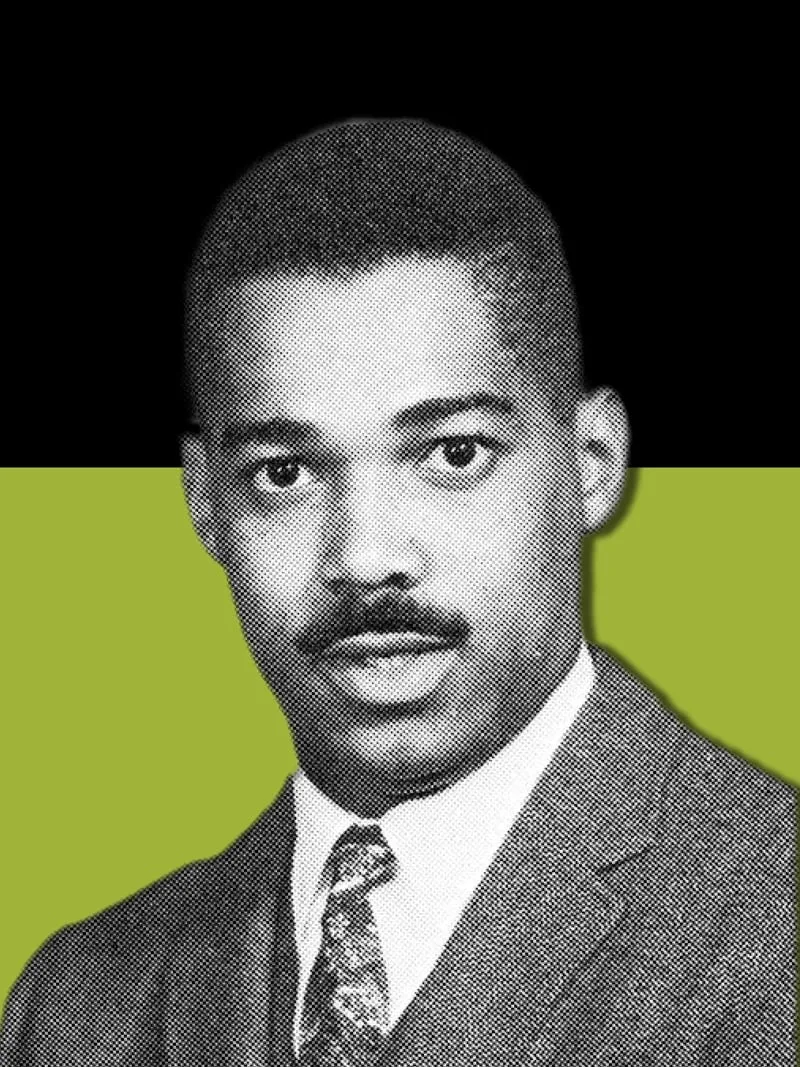
E. Theodore Lewis Jr. HBS Annual Report, 1969. Baker Library, Harvard Business School.
E. Theodore Lewis Jr.
MBA 1969
When E. Theodore Lewis Jr. arrived at HBS he "was really disappointed in Harvard. Its reputation was that it was the best of the country's educational institutions and would be leading in a number of social justice issues . . . . We started sharing our points of view about what was going on at the School. There was a range of feelings about the fact that out of a class of 700 students there were only six African Americans." (9) He remembered that in the HBS curriculum at the time, "a lot of the things that were being discussed in cases clearly had none of the appreciation of what we now call diversity . . . certainly African American issues were just a small part of the agenda, if any part of the agenda." (10) Of that era, Lewis said, "We felt particularly emboldened—that we had nothing to lose." (11)
Lewis worked in a number of executive search firms and consulting companies. He has provided senior–level strategic management advice and recruitment leadership as a member of McKinsey & Co., Russell Reynolds, and Accenture (formerly Andersen Consulting) senior management. He also serves on the boards of A Better Chance (ABC) and Early Steps.
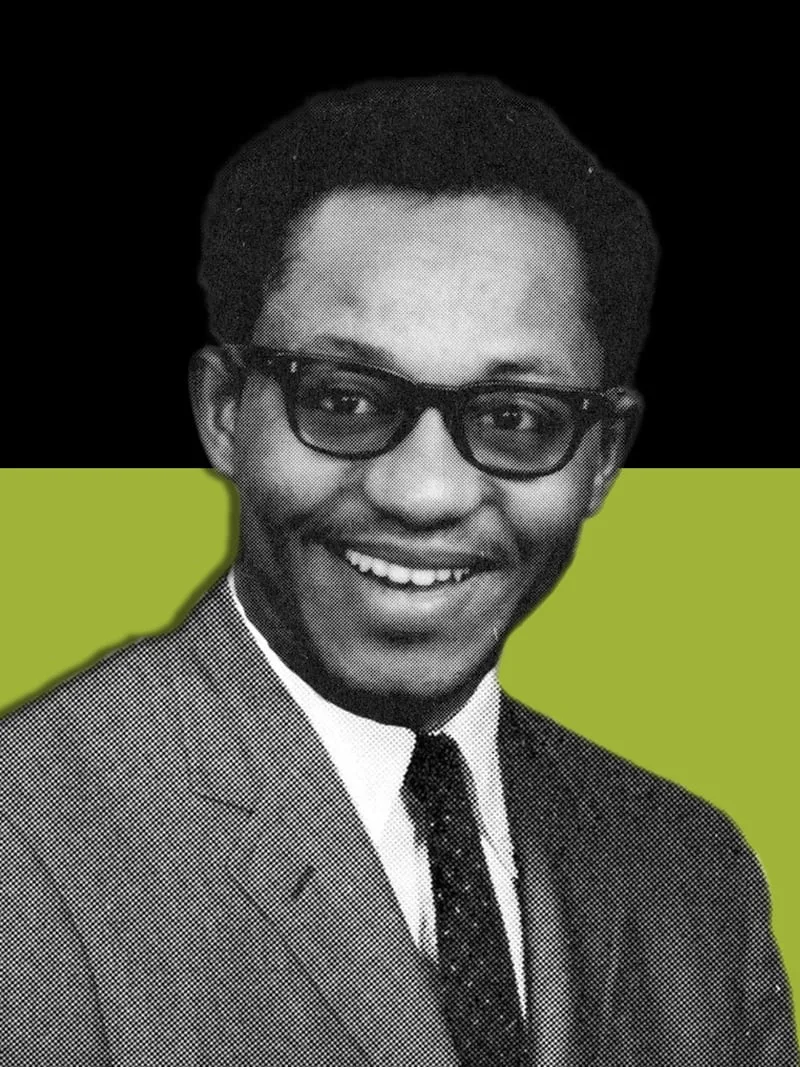
George R. Price. MBA Student Files, 1970. Baker Library, Harvard Business School.
George R. Price
MBA 1970
George R. Price worked closely with Lillian Lincoln Lambert to recruit Black students and thereby significantly increase the number of African Americans attending HBS. In 1967, AASU's founders represented five of only six Black students in the incoming class. In the summer of 1968 Price worked in Kansas City, Missouri where he oversaw an experimental summer project for Gordon T. Beaham III (HBS '58). The project, Black Light, Inc., produced comic strips for a television cartoon series marketed for Black children. (12) Price returned to HBS the following year where he continued to be involved in the efforts of AASU.
After graduation Price worked in international marketing for Levi Strauss in the company's headquarters in San Francisco and also in Oslo, Norway and Brussels, Belgium. He led efforts advising the company not to manufacture products in South Africa during apartheid. He also served as a strategic consultant to several African American companies. Price, who died in 2012, founded Price & Associates, a venture development firm, based in Silver Spring, Maryland.
Core Demands & Proposals
To address the educational and social experience of African American students at HBS, AASU proposed four core goals: increase Black enrollment in the MBA program; raise more fellowship funds for Black students; add new courses relevant to Black students; and promote meaningful social interaction and career development. (13) In 1968, AASU founders traveled to their alma maters and other colleges and universities to recruit students. With the HBS administration, members of AASU in its early years succeeded in dramatically raising the number of African American students (27 African Americans graduated in 1970 and 58 in the following year). They also created the impetus for increased fellowship funding, courses on economic development in underserved communities, and broader representation in the HBS faculty.
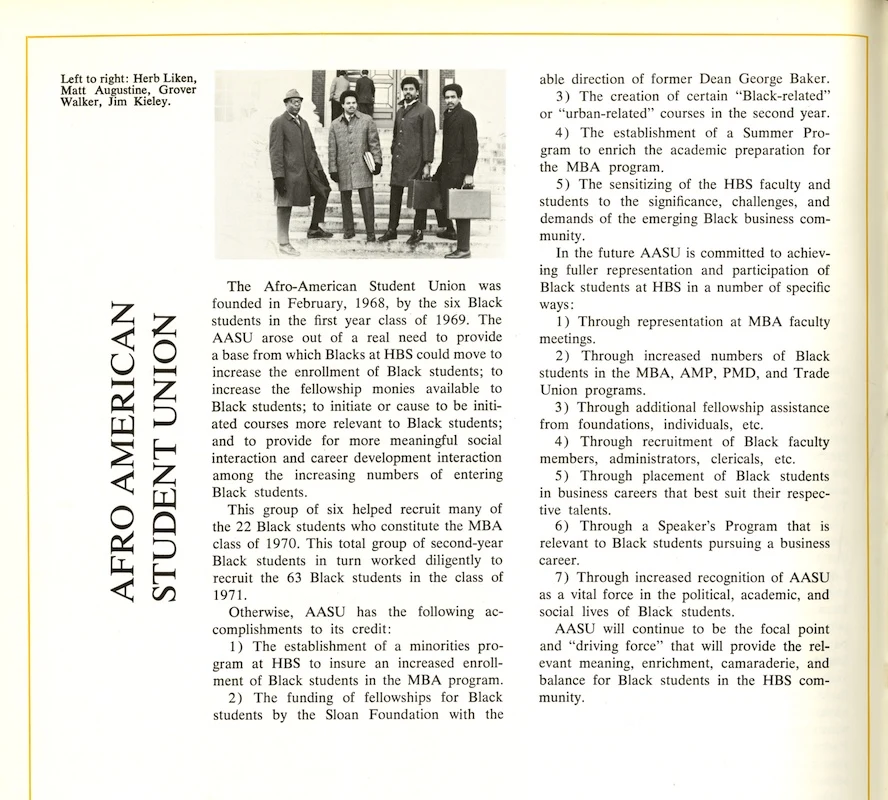
AASU leaders Herb Liken, Matt Augustine (MBA 1971), Grover Walker (MBA 1971), Jim Kieley. HBS Annual Report,1970. Baker Library, Harvard Business School.
Clubs at HBS, which were officially noted in the HBS yearbooks, represented an integral part of the student experience. A photograph of AASU's members first appeared in the 1970 HBS yearbook with a description of the organization's achievements and future goals.

Letter to incoming MBA students (Class of 1971), May 25, 1969. African-American Student Union Records, c. 1. Baker Library, Harvard Business School.
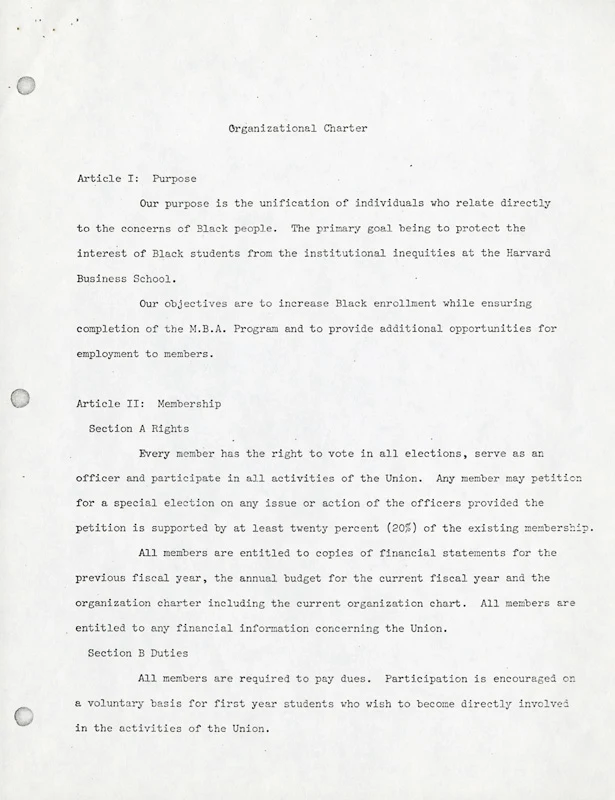
“Afro-American Student Union Proposed By Laws,” ca. 1969. African-American Student Union Records, c. 1. Baker Library, Harvard Business School.
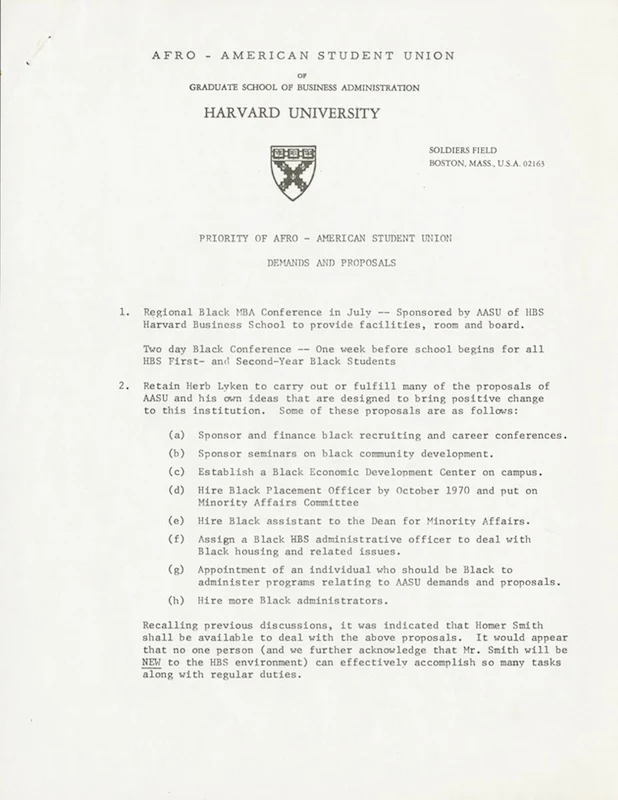
“Priority of Afro-American Student Union: Demands and Proposals,” ca. 1969. African-American Student Union Records, c. 1. Baker Library, Harvard Business School.

“Afro-American Student Union Proposed By Laws,” ca. 1969. African-American Student Union Records, c. 1. Baker Library, Harvard Business School.

“Priority of Afro-American Student Union: Demands and Proposals,” ca. 1969. African-American Student Union Records, c. 1. Baker Library, Harvard Business School.

Letter to incoming MBA students (Class of 1971), May 25, 1969. African-American Student Union Records, c. 1. Baker Library, Harvard Business School.

“Priority of Afro-American Student Union: Demands and Proposals,” ca. 1969. African-American Student Union Records, c. 1. Baker Library, Harvard Business School.

Letter to incoming MBA students (Class of 1971), May 25, 1969. African-American Student Union Records, c. 1. Baker Library, Harvard Business School.

“Afro-American Student Union Proposed By Laws,” ca. 1969. African-American Student Union Records, c. 1. Baker Library, Harvard Business School.
The AASU charter stated its purpose as "the unification of individuals who relate directly to the concerns of Black people," with the goal "to protect the interest of Black students." (14) AASU outlined 52 core demands and proposals. In a letter reaching out to the incoming class of 1971, AASU president Clifford E. Darden (MBA '69, DBA '82) expressed his views on AASU's accomplishments and encouraged incoming students to become active members in the newly formed organization.
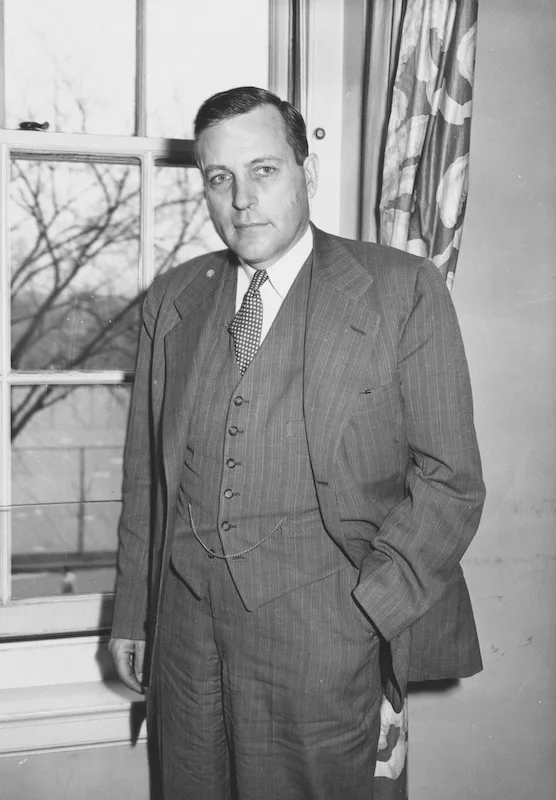
Dean George P. Baker, ca. 1952. HBS Archives Photograph Collection: Faculty & Staff. Baker Library, Harvard Business School. olvwork399597
Dean of HBS from 1962 to 1970 and a member of the HBS faculty for 38 years, George P. Baker played an integral role in responding to and moving forward the goals of AASU. AASU founders worked closely with Baker and acknowledge his contributions to the organization. "Dean Baker was interested in what we were saying," Clifford E. Darden (MBA '69, DBA '82), said. (15) Baker sought funding to make the recruitment of Black students possible, "not something that most deans would have done in that environment in 1968," Lillian Lincoln Lambert (MBA '69), remembered. (16) He also established a fellowship program providing financial support for African Americans while they were attending HBS. Baker's belief in the importance of business education for the achievement of economic equality prompted him to initiate a fellowship program for African American students at ten graduate schools of business administration, known as the Council on Graduate Management Education (COGME).
Early Years & Activism
Throughout its early years, AASU directed its student activism on behalf of Africans Americans at HBS and beyond. "[W]e the Black students did take a self–determined, moral act in organizing ourselves to address such societal issues of racism, poverty, neglect, exclusion and tokenism," AASU co–founder A. Leroy Willis (MBA '69) wrote. (17) In December 1969, AASU students voiced their concerns about the hiring of minorities on Harvard construction sites, and in May 1970, they held a strike protesting the killing of two Black students in Jackson, Mississippi. AASU invited speakers such as civil rights activist Rev. Jesse Jackson to campus. Working groups within AASU also addressed issues like discriminatory recruiting practices and Harvard's investment policies. The activist efforts of AASU inspired the formation of other clubs including the Hispanic Club, Latin American Club, and Women's Club (later the Women's Student Association).
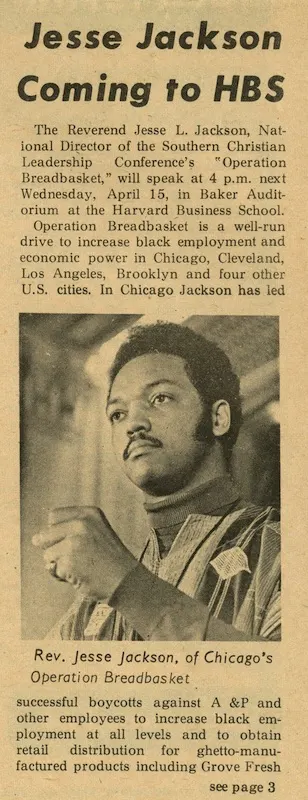
The HarBus News, April 9, 1970. Baker Library, Harvard Business School.
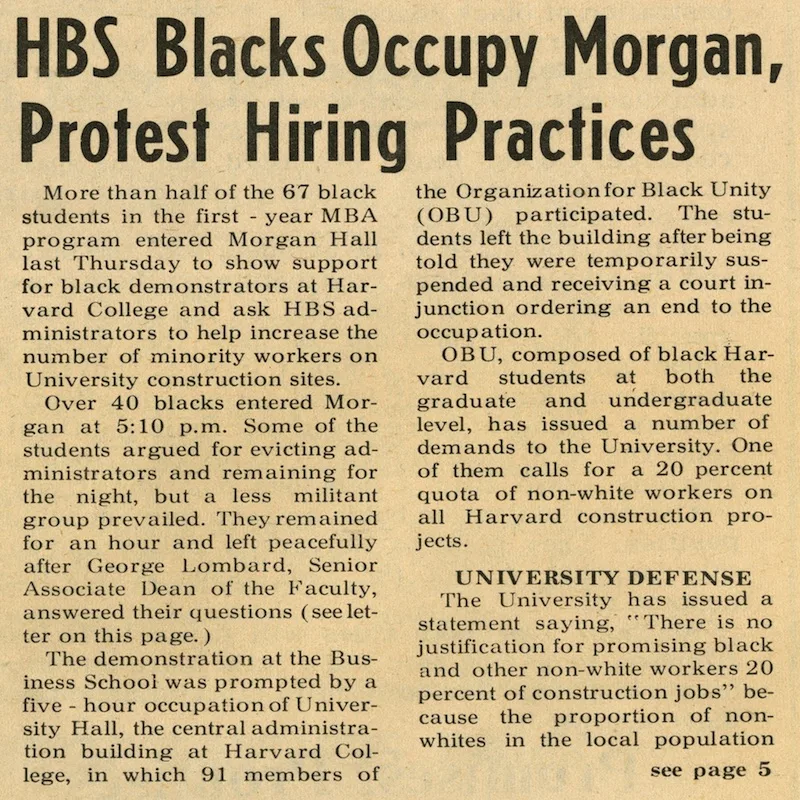
The HarBus News, December 18, 1969. Baker Library, Harvard Business School.
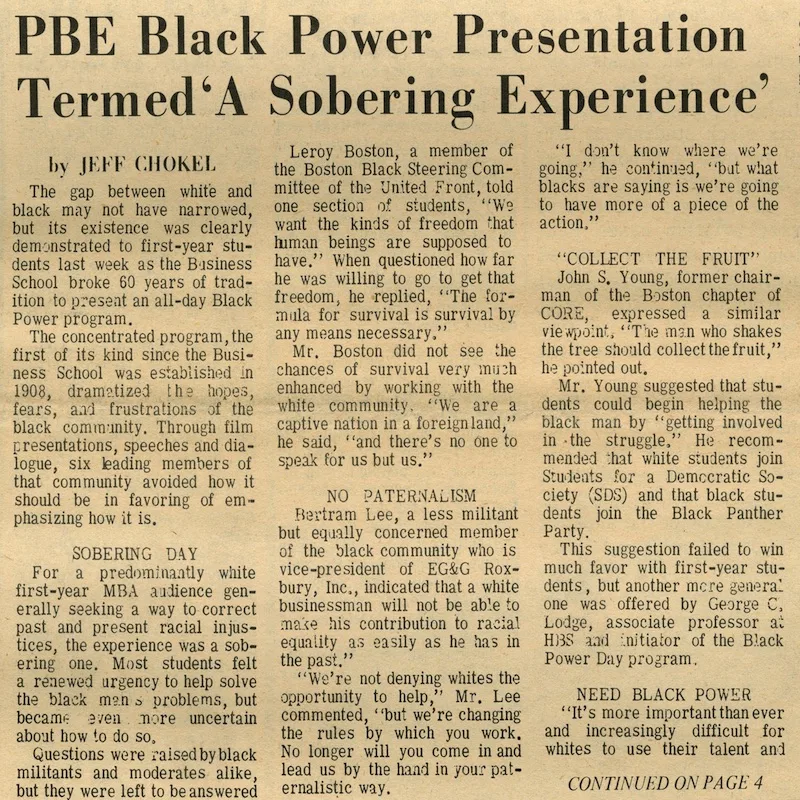
The HarBus News, December 5, 1968. Baker Library, Harvard Business School.
HBS responded in part to growing student unrest by organizing Black Power Day in November 1968. The full–day program included presentations and discussions with African American leaders from Boston and Cambridge.

“AASU statement of support for the Pan-African Liberation Committee (PALC) and Harvard College's Afro in their takeover and occupancy of the Harvard University Administration Building,” April 23, 1972. African-American Student Union Records, c. 1. Baker Library, Harvard Business School.
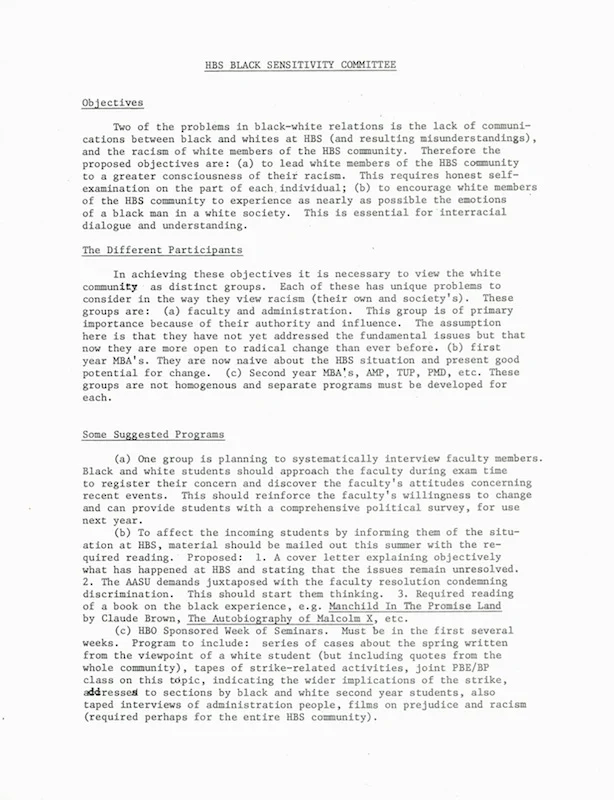
“HBS Black Sensitivity Committee student proposal,” ca. 1970. African-American Student Union Records, c. 1. Baker Library, Harvard Business School.
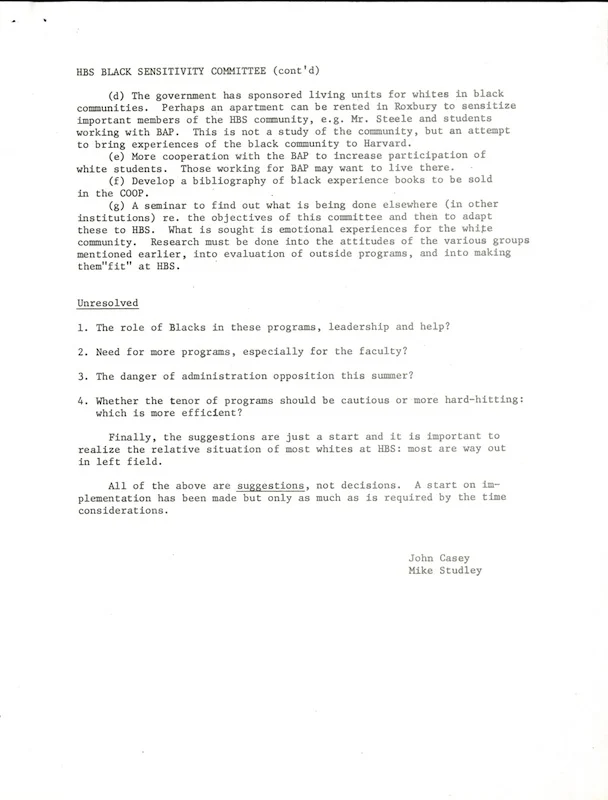
“HBS Black Sensitivity Committee student proposal,” ca. 1970. African-American Student Union Records, c. 1. Baker Library, Harvard Business School.
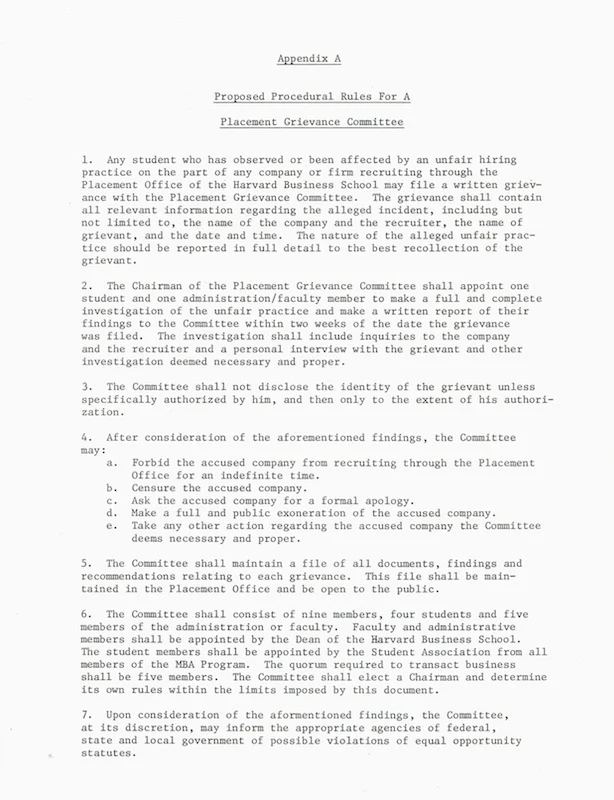
“Appendix A: Proposed Procedural Rules for a Placement Grievance Committee,” ca. 1970. African-American Student Union Records, c. 1. Baker Library, Harvard Business School.

“HBS Black Sensitivity Committee student proposal,” ca. 1970. African-American Student Union Records, c. 1. Baker Library, Harvard Business School.

“HBS Black Sensitivity Committee student proposal,” ca. 1970. African-American Student Union Records, c. 1. Baker Library, Harvard Business School.

“Appendix A: Proposed Procedural Rules for a Placement Grievance Committee,” ca. 1970. African-American Student Union Records, c. 1. Baker Library, Harvard Business School.

“AASU statement of support for the Pan-African Liberation Committee (PALC) and Harvard College's Afro in their takeover and occupancy of the Harvard University Administration Building,” April 23, 1972. African-American Student Union Records, c. 1. Baker Library, Harvard Business School.

“HBS Black Sensitivity Committee student proposal,” ca. 1970. African-American Student Union Records, c. 1. Baker Library, Harvard Business School.

“Appendix A: Proposed Procedural Rules for a Placement Grievance Committee,” ca. 1970. African-American Student Union Records, c. 1. Baker Library, Harvard Business School.

“AASU statement of support for the Pan-African Liberation Committee (PALC) and Harvard College's Afro in their takeover and occupancy of the Harvard University Administration Building,” April 23, 1972. African-American Student Union Records, c. 1. Baker Library, Harvard Business School.

“HBS Black Sensitivity Committee student proposal,” ca. 1970. African-American Student Union Records, c. 1. Baker Library, Harvard Business School.
The AASU Black Sensitivity Committee was formed to encourage the self–examination of "white members of the HBS community . . . essential for interracial dialogue and understanding." (18) Suggested activities included faculty outreach and student exposure to AASU demands, required readings, and seminars. Students who believed they had been subjected to discriminatory hiring practices by companies recruiting through the HBS Placement Office could file a grievance through the AASU Placement Grievance Committee. AASU supported the activities of the Pan–African Liberation Committee (PALC), organized by Harvard students, in demanding the University support the Angolan struggle for independence from Portugal by divesting its stock in Gulf Oil, a supporter of the colonial government.
Letter to faculty member from members of the AASU, April 25, 1969. AASU Records, Baker Library, Harvard Business School.
Clifford E. Darden in “African-American Student Union Marks 25 Years at HBS,” 37.
Clifford E. Darden in Jennifer Gillespie, ed., “We Were Just Doing What Needed to Be Done,” Harvard Business School Bulletin, March 2018, 60.
Interview with A. Leroy Willis. “The African-American Student Union of HBS: A Salute to the Past, A Challenge to the Future” (014871962_VT_0006), 1994. Baker Library, Harvard Business School.
A. Leroy Willis in Gillespie, ed., “We Were Just Doing What Needed to Be Done,” 59—60.
Interview with Lillian Lincoln Lambert, “The African-American Student Union of HBS: A Salute to the Past, A Challenge to the Future” (014871962_VT_0006), 1994. Baker Library, Harvard Business School.
Lillian Lincoln Lambert in Gillespie, ed., “We Were Just Doing What Needed to Be Done,” 61.
Ibid., 62.
E. Theodore Lewis Jr. in Gillespie, ed., “We Were Just Doing What Needed to Be Done,” 59.
Interview with E. Theodore Lewis, “The African-American Student Union of HBS: A Salute to the Past, A Challenge to the Future.”
Lewis in Gillespie, ed., “We Were Just Doing What Needed to Be Done,” 60.
Luci Horton, “A Slice of Life Drawn from the Ghetto,” Ebony, February 1974, 82.
Letter to incoming students from Clifford E. Darden, chairman, “General Letter” Committee, the AASU, May 25, 1969. AASU Records, Baker Library, Harvard Business School.
Afro-American Student Union Proposed Bylaws, undated. AASU Records, Baker Library, Harvard Business School.
Darden in Gillespie, ed., “We Were Just Doing What Needed to Be Done,” 60.
Interview with Lillian Lincoln Lambert, “The African-American Student Union of HBS: A Salute to the Past, A Challenge to the Future.”
A. Leroy Willis, “Return to Harvard: To Build Upon a Legacy,” a speech commemorating 25 years of services to America by HBS Black graduates (1968-1993), September 1993. AASU Records, Baker Library, Harvard Business School.
John Casey and Mike Studley, student proposal for HBS Black Sensitivity Committee, 1970. AASU Records, Baker Library, Harvard Business School.